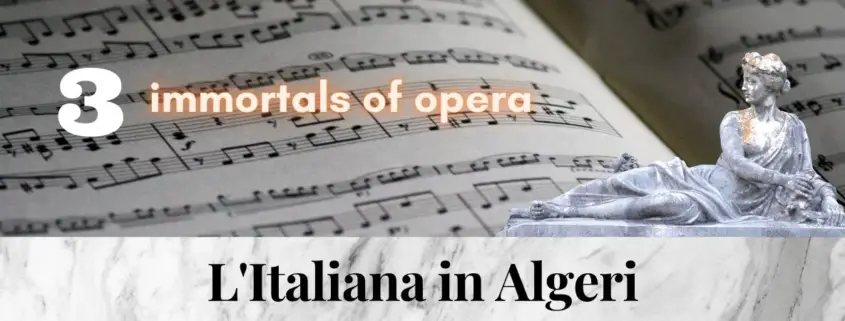The music of Italiana in Algeri is ravishing, sparkling with wit and melody – the finale of the first act may be considered the invention of slapstick comedy par excellence. For the female lead Rossini created the voice type of the coloratura mezzo-soprano, to which he would create further monuments a few years later with Rosina from Barbiere and Angelina from Cenerentola.
Lindoro’s Despair – The Cavatina with all the high C’s
With the elegiac cavatina of Lindoro, Rossini presents a reflective character. For Rossini, even the inwardly directed and elegiac had a place in a buffo opera. Lindoro and Isabella are the only characters in the opera who embody both serious and serene aspects, giving them depth and placing them above all other characters in the Rossinian hierarchy.
The Elegy of Lindoro is introduced with a beautiful French horn melody. This cavatine is a veritable parforce ride for the tenor. It is written in a very high tessitura, the tenor sings constantly above the F and often even in the C and D regions. In addition, there are many tricky ornaments and scales.
We hear Juan Diego Florez, the Rossini tenor of the 21st century. His technique is outstanding and he masters this aria with a perfection that captivates. He produces his high notes seemingly effortlessly and the ornamentation is perfect.
Languir per una bella – Florez
Isabella is captured – Rossini “invents” the coloratura mezzo-soprano
Haly and his corsairs have come upon an Italian ship that has been the victim of a storm. They rob all the belongings and arrest the people of the ship. Among the captured women is Isabella. She is the mistress of Lindoro. She had set out to free her lover from captivity. Now she herself has fallen into the hands of the Muslims. It is clear to her that it is now necessary to keep a cool head and skilfully use the woman’s weapons.
Isabella gets a great scena ed aria for her first appearance. Using the slow cavatine (also called cantabile) “Cruda sorte” as an example, we hear Rossini’s coloratura music. Coloratura is not only a technical specification (a fast sequence of notes with short note values of the same length), but there is a whole musical culture behind it, rooted in bel canto. Its artistry was developed and brought to perfection by the castrati, among others, over more than a hundred years.
Marylin Horne was one of the singers who fueled the Rossini Renaissance with her artistry. Her coloratura technique was masterful. Lightness and perfection of her voice can be marveled at in the following excerpt. Many experts consider her the most technically perfect coloratura singer of the post-war period.
Cruda sorte … Gia so per pratica – Horne
Isabella Struggles with Her Beau Taddeo
For this performance of the two captured Italians, Rossini wrote a great duet. It gives the two characters a great opportunity to skillfully and effectively stage their singing to the most beautiful music. We hear 2 interpretations from 2 different eras.
In this contribution you can meet Conchita Supervia as Isabella, a singer of the twenties in perhaps her most famous roles. Her duet with Vincenzo Bettoni “Ai cappricci della sorte” is great cinema, she has a good sound quality despite the recording year 1928. She single-handedly brought this opera back from its 50 year slumber. Jürgen Kesting comments on this recording in “The Great Singers of the 20th Century”: “When Conchita Supervia as Isabella says to Taddeo that a foolish lover is a torment (“sciocco amante”) and that she would rather have a Turk than a dolt (“meglio un turco che un briccone”), one sees the tragicomic scene before one with the hands and the whole body and the excitement of the tone. She doesn’t just perform music, she performs it.”
Ai capricci – Supervia/Bettoni






Leave a Reply
Want to join the discussion?Feel free to contribute!